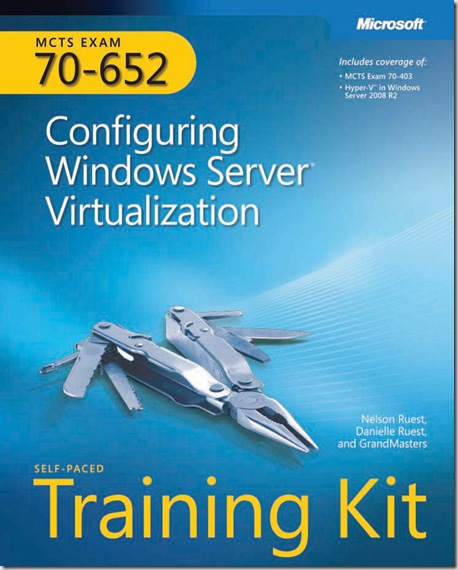New book: MCTS Self-Paced Training Kit (Exam 70-652): Configuring Windows Server Virtualization
Server virtualization is one of the hottest technologies today, despite a very tough economy. According to a recent IDC study, spending on virtualization is expected to approach $15 billion worldwide this year. The study estimates that over three-quarters of all companies with more than 500 employees are deploying virtual servers.
A strong growth in virtualization means more and better IT jobs for those skilled in the technology. And getting certified is a great way to validate those skills to your current and prospective employers.
To help you on the path to certification, we’re introducing the newest Microsoft Press Training Kit: MCTS Study Guide (Exam 70-652): Configuring Windows Server Virtualization (Microsoft Press, 2009; ISBN: 9780735626799; 656 pages), authored by Nelson Ruest and Danielle Ruest.
Danielle and Nelson were kind enough to send a few words on the book and their thoughts on Virtualization. Merci beaucoup, mes amis!
From Danielle and Nelson Ruest:
Over the course of 2007 and 2008, we toured the U.S. to deliver a series of presentations on virtualization and its impact in the modern datacenter, as well as its impact on server sprawl. We visited over 30 cities and talked to thousands of people in all stages of implementation.
One thing we discovered was that in each and every case, people wanted to know how to move to virtualization—what to do first, how to prepare their infrastructure, how to migrate their physical machines, how to administer hosts and virtual machines, and how to make the most of virtualization in general. This is what we wrote about in the 70-652 Training Kit, beyond providing solid support for passing the exam.
From our discussions with conference attendees, we knew that there are three starting points for organizations moving to Hyper-V virtual infrastructures:
- Organizations that are not using virtualization at all
- Organizations that are using software virtualization tools such as Microsoft Virtual Server
- Organizations that are using a hypervisor other than Microsoft Windows Server with Hyper-V
The book begins by outlining each of these three potential positions and then moves on to provide a structured step-by-step approach to implementing Hyper-V based on your own starting point. It covers the creation of the host server infrastructure, the preparation of your administrative framework for the infrastructure, the migration of server operating systems—whether physical or virtual—to Hyper-V virtual machines, the implementation of high availability strategies for your VMs, the automation of Hyper-V operations through Windows PowerShell, the implementation of a secure Hyper-V infrastructure and more.
Like all of our other books, this guide takes you through the various stages of deployment and then provides guidance on how to administer the infrastructure once it is in place. This is also the approach we used in MCITP Self-Paced Training Kit (Exam 70-238): Deploying Messaging Solutions with Microsoft® Exchange Server 2007. In both cases, the guides let you learn all you need to know to pass the exam, but also provide everyday guidance on how to use the product.
In addition, the 70-652 Training Kit provides deep content for studying and passing exam 70-403, Configuring System Center Virtual Machine Manager 2008 as well as providing updates on Hyper-V R2 features and functionalities. Two chapters have been made available for free: Chapter 6, Migrate to Hyper-V and Chapter 8, Securing Hosts and Virtual Machines. Find them here and get your first taste of what a Hyper-V deployment can and should be like. Good luck with the exam!
Danielle and Nelson
Note: You can view Danielle and Nelson Ruest’s Virtualization presentation here.
